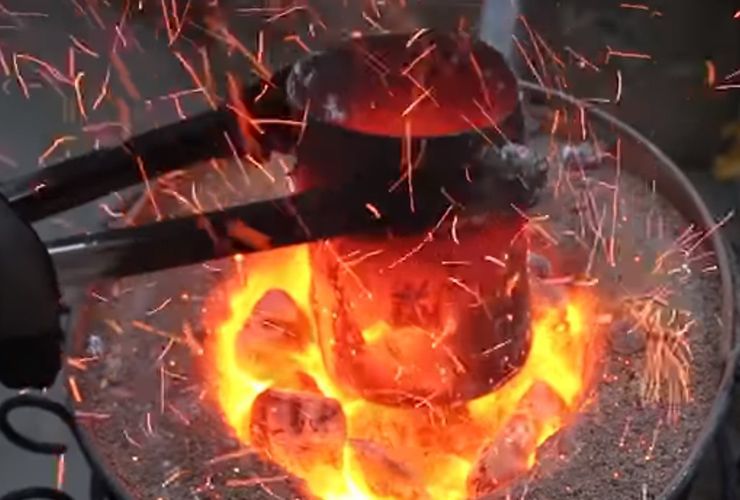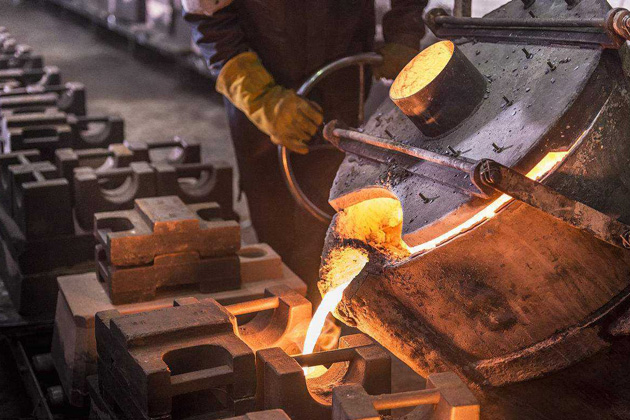Discover the Innovative Strategies Utilized in a Metal Foundry for Superior Casting Outcomes
In today's competitive production landscape, metal foundries are increasingly adopting cutting-edge strategies to boost spreading outcomes - Aluminum Foundry. Advanced computer system simulations permit exact modeling of molten metal behavior, while 3D printing enables rapid production of complicated mold and mildews. In addition, environment-friendly products and automation simplify procedures. These growths assure considerable renovations in performance and quality control. The effect of these technologies on sustainability and manufacturing methods remains to be totally explored.
Advanced Computer System Simulations in Metal Casting
Advanced computer simulations have reinvented the metal spreading process by enhancing accuracy and efficiency. These advanced tools enable engineers to create online designs of cast parts, enabling them to analyze and forecast the habits of molten metal during the spreading stage. By mimicing various criteria such as temperature level, circulation price, and cooling rates, suppliers can recognize prospective issues before physical manufacturing starts.
This positive approach reduces waste and lessens costly mistakes, eventually causing improved item high quality. Additionally, simulations assist in the optimization of mold and mildew layouts, making sure that they fulfill the particular demands of each project. The combination of computational liquid dynamics (CFD) and limited aspect evaluation (FEA) further adds to the precision of these simulations, giving insights that were formerly unattainable. As a result, advanced computer simulations have ended up being an essential element of modern-day metal foundries, significantly advancing the industry's capacities.
3D Printing for Molds and Patterns
3D printing has actually become a groundbreaking technique for developing molds and patterns in the metal foundry sector. This technology allows the rapid production of intricate geometries that standard manufacturing methods battle to accomplish. By utilizing additive production, foundries can create complex layouts with reduced lead times and material waste. The ability to create mold and mildews on need enables greater versatility in design iterations, assisting in faster prototyping and modifications.
In addition, 3D printing can utilize a variety of materials, including plastics and metals, customized to specific casting needs. This versatility improves the precision of mold and mildews, leading to superior casting end results with enhanced surface coatings. Additionally, the decrease in the variety of components called for streamlines assembly processes, additionally enhancing manufacturing performance. As foundries remain to take on 3D printing, they are positioned to redefine sector requirements, leading the way for innovation and improved performance in metal spreading procedures.
Eco-Friendly Products and Processes
As the metal foundry market faces enhancing stress to decrease its environmental footprint, the adoption of environmentally friendly materials and processes has ended up being necessary. Factories are currently discovering lasting alternatives to traditional products, such as using recycled metals and bio-based binders. These products not only minimize waste but also lower power consumption throughout production.
Additionally, developments in sand casting techniques have brought about using synthetic sands that are less unsafe to the setting. Foundries are additionally implementing innovative processes like liquified metal therapy that reduces emissions and improves the quality of cast items.
Water-based coatings have actually replaced harmful solvents, advertising a safer work environment. By integrating these environment-friendly techniques, metal foundries can noticeably decrease their ecological effect while preserving top quality spreading outcomes. This change not only profits the atmosphere but additionally aligns with the expanding consumer demand for lasting manufacturing solutions
Automation and Robotics in Foundry Operations
While the metal foundry sector embraces innovation, the integration of automation and robotics is transforming procedures substantially. Automated systems enhance processes such as mold making, metal putting, and casting ending up, greatly improving performance. Robotics facilitate the handling of heavy materials, reducing the danger of workplace injuries and making sure safer settings.

Better, the usage of automated assisted lorries (AGVs) maximizes product transport within facilities, ensuring prompt shipment of components to proper workstations. By applying these innovations, foundries can adapt to varying demands with higher agility, eventually resulting in boosted earnings and competitiveness in the market. As automation and robotics proceed to evolve, they hold the prospective to redefine standard foundry methods and drive more advancements in casting techniques.
Real-Time Monitoring and High Quality Control Techniques
The advancements in automation and robotics have actually led the way for a lot more sophisticated strategies to high quality guarantee in metal foundries. Real-time monitoring systems use advanced sensors and data analytics to track essential specifications throughout the casting process. These systems constantly examine variables such as product, temperature level, and stress structure, enabling prompt detection of inconsistencies from established criteria.
Quality assurance strategies currently integrate equipment discovering algorithms that assess historical information to predict potential problems prior to they happen. This positive technique reduces waste and improves general production effectiveness. Furthermore, incorporated responses loops permit rapid modifications, making certain that each spreading fulfills rigid high quality demands.
The application of electronic doubles-- online replicas of physical assets-- has likewise reinvented quality control, allowing designers to imitate and maximize procedures in real-time. Together, these ingenious methods substantially boost the dependability and high quality of castings, establishing brand-new market standards you could try here in metal foundry procedures.
Often Asked Inquiries
What Sorts of Metals Are Commonly Cast in Shops?
Commonly cast steels in foundries include aluminum, brass, bronze, and iron. Each metal shows one-of-a-kind homes, making them appropriate for different applications, such as auto components, machinery, and artistic sculptures, boosting their flexibility in production.

How much time Does the Casting Process Commonly Take?
The casting process normally a knockout post takes numerous hours to days, relying on elements such as the complexity of the mold and mildew, sort of metal made use of, and air conditioning demands. Each stage affects the overall duration noticeably.
What Security Actions Are in Location for Foundry Employees?

Exactly how Are Defects in Castings Identified and Addressed?
Flaws in castings are identified via aesthetic examinations and non-destructive screening approaches. When found, foundry employees resolve them by refining processes, adjusting material compositions, and applying restorative measures to guarantee top quality and conformity with requirements.
What Is the Expense Range for Metal Casting Providers?
The expense variety for metal casting solutions typically differs in between $1 to $10 per pound, depending on elements such as product type, intricacy of the design, and manufacturing volume, impacting total prices considerably.
In today's affordable manufacturing landscape, metal foundries are increasingly taking on ingenious techniques to improve casting outcomes. As the metal foundry industry encounters increasing pressure to decrease its ecological footprint, the adoption of click here for more info environment-friendly materials and processes has actually ended up being important. Shops are now discovering sustainable choices to typical materials, such as using bio-based binders and recycled steels. By incorporating these environment-friendly techniques, metal foundries can considerably reduce their eco-friendly impact while maintaining top notch spreading outcomes. The advancements in automation and robotics have led the means for much more innovative approaches to high quality guarantee in metal foundries.